
NAPLES


A History of the City:

The history of Naples is not a simple one, consisting of numerous events of populations and cultures over a period of three thousand years. The summary of such a complex history is difficult and exhaustive, therefore a look at some of the most significant episodes can help one to understand the complexity of Naples’ past.
Though the origin of Naples is not clear, most believe the city was founded around the 7th century BC. By a colony of Greeks from nearby Cumae. The first settlement being located in the area of Monte Echial, today known as the hill of Pizzofalcone, its name most likely being Parthenope. It was later changed to Paloepolis, after the creation of a new centre called Neapolis, which is today the historical center. Around 320 B.C. the city was conquered by the Romans who governed it until the fall of the Western Roman Empire in 476. From the 6th century to the 8th century Naples was dominated by Byzantium but repeatedly attacked by the Gothics, then by the Lombards. From 661 to 1139 Naples was a Dukedom, first under Byzantium, then as an independent government. In 1140 after much resistance, the city collapsed under the siege of the Normans. In 1194 the Swabians conquered the city which remained in their power until the Angevin victory in 1266. The Kingdom of Naples under French rule lasted two centuries. In 1503 the long period of independence for the kingdom was broken and Naples became a simple colony under the control of the Spaniards. The Spanish Viceroy remained until 1707 when the Austrian Rule of thirty years began. In 1734 Naples regained its independence under Charles of Bourbon. The Bourbons governed the city continuously until 1860, with brief exceptions. In 1861 Naples became part of the Kingdom of Italy.
The Area around the Port:
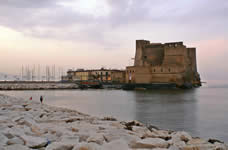
Castel dell’Ovo: This fortress jutting into the sea is one of the first settlements of the city, located on the tiny island of Megaride. The castle was built in the 9th century on the ruins of more ancient buildings. The castle houses the Museum of Ethnoprehistory by C.A.I.
“The Legend of the Egg” – Opinions vary as to the origin of the curious name given to Castel dell’Ovo – Castle of the Egg. One possible explanation being the shape of the castle. However, tradition has it that the name came from a magic egg believed to be hidden in the castle which determined its fate and that of the entire city. As long as the egg remained intact, both would be protected from catastrophes. The magic spell was supposed to have been originally cast on the ancient egg by the Latin poet Virgil, who, according to medieval legends, possessed supernatural powers and the gift of divination.
The Royal Palace: 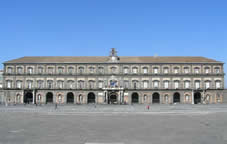
The palace was built between 1600 and 1630 by the Viceroy Ferrante of Castro after Dominico Fontana’s design. The Royal apartments, the small Theatre of the Court, the Diplomatic Corps room, the Throne room, the Hercules room and the Palatine Chapel can all be visited. In thirty halls a rich collection of paintings, sculptures, tapestries, furniture and porcelain is on display. The old Ball Rooms house the National Library where the papyri from Ercolano are kept.
Castel Nuovo and the Civic Museum:
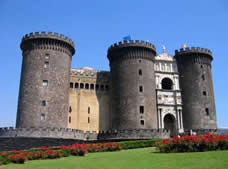
This castle also known as Maschio Angioino, was built between 1279 and 1282 by Charles of Anjou. Later the castle was completely changed by Alfonso of Aragon in the 15th century. The Chapel of St Barbara, originally decorated by Maso di Baco, remains from the French period. At the entrance of the castle is the magnificent Arch of Triumph, built to commemorate the Aragonese victory. The castle houses the Civic Museum which contains 15th and 20th century paintings and sculptures primarily from Neapolitan churches.
Via Duomo:
Duomo: This cathedral was built in the 14th century by Robert of Anjou. During the construction the ancient Church of St. Restituta and the Bapitistery of St. Giovanni were incorporated into the cathedral. Particularly worth visiting is the chapel where the Treasure of St. Gennaro is kept. The famous Miracle of the Blood, when the blood of the martyred San Gennaro liquefies (hopefully) in its silver ampoule every September 19th before an audience of thousands massed in front of the duomo’s altar. Should the San Gennaro not cooperate, the city winds up paying, or so the people of Naples believe; eruptions of Vesuvius, cholera outbreaks, and defeats of the Naples soccer team have all been blamed on the saint when the miracolo has failed to occur.
Pio Monte della Misericordia: The church was built in the 17th century by the congregation of the same name whose members were devoted to charity activities. Caravaggio’s masterpiece, the “Seven Works of Mercy” can be seen above the main altar. Also noteworthy is the rich picture gallery on the noble floor of the palace.

Spaccanapoli:
Gesu` Nuovo: The forbidding facade of this church dominates the square of the same name. Venture inside and you will be intoxicated by the swirls of stucco, inlaid marble and gilt work, not to mention the huge fresco by Francesco Solimene, paintings by Luca Giordano, and marble statues by Fanzago and Jose Ribera.
Capella San Severo: Now deconsecrated and open as a private museum, the chapel hosts some of the most spectacular trompe l’oeil frescoes and statues by San Martino. Figures shrouded in nets and veils carved from marble appear to be light as silk.
Santa Chiara: The church built between 1310 and 1328 is the leading monument of Angevin Gothic in Naples. It is in the Provencal-Gothic style with some influences of local art. It contains several tombs of the members of the French Court, some of them by Tino da Camaino. Particularly worth a visit is the beautiful majolica tiled cloister, Chiostro delle Clarisse, the most famous in Naples. Not typical of any convent, the benches and octagonal columns holding the trellis of vine shading the private garden are comprised of hand painted majolica designed by Domenico Antonio Vaccaro, with landscapes and yellow and green floral motifs by Donato and Giuseppe Massa. Where the real vines leave off and the painted ones take over is hard to say.
The Area of the National Museum:
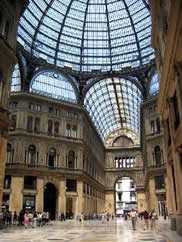
Museo Archeologico Nazionale: The museum was founded by Charles Bourbon to house his personal collection. The museum was built in what were barracks in 1586, formerly named the “Palace of the Royal Studies”. In 1777, Ferdinand IV incorporated the Bourbon Museum and the Royal Library into the building, and throughout the 18th and 19th centuries further enlargements were made.
The museum houses a massive collection of treasures, encompassing some of the best finds from Pompeii. Among the most noteworthy are silver, ivory and terra-cotta objects from houses in the Vesuvian area. Paintings and mosaics preserved from villas in Pompeii and Herculaneum give further insight into everyday Roman customs and beliefs. The Farnese collection includes the Farnese Bull and Farnese Hercules – two pre-eminent sculptures from Rome.
Museo Madre: A modern art extravaganza, a spruced up Palazzo Donnaregina, the museum hold four floors of good contemporary art, ranging from Francesco Clemente to Damien Hirst and Andy Warhol. The young hip black-clad attendants are delightfully well informed and love to interact with the public in an array of languages.
Orto Botanico: Founded in 1807 by Joseph Bonaparte and Prince Joachim Murat, meant to be an oasis from the commotion of Naples, this is one of the largest of all Italian botanical gardens, comprising 30 acres. Greenhouses from the 19th century along with picturesque paths hold a significant collection of trees, shrubs, cactus and floral specimens from around the world.
Vomero:
Take one of the funicular railway lines up the hill to Vomero for magnificent views of the city center and the Bay of Naples. Take a walk along the atmospheric streets in the heart of the district revealing the eclectic range of shops and goods, including the Daniele pasticceria in Via Scarlatti, known for its delectable cakes.
Castel Sant’Elmo: The imposing fortress broods over the city below, it seems to be policing you wherever you walk in Naples. Built by Charles I of Anjou in 1275 and later enlarged by the Angevin kings, it was then transformed in the 16th century by Pedro Scriva into its present stoutly fortified six point star configuration. The castle cells housed many prisoners over the centuries, including the philosopher monk Tommaso Campanella, leaders of the Masaniello rebellion, and even patriots of the short lived 1799 Neapolitan rebellion against the Bourbons. Today the larger rooms of the castle host contemporary art exhibitions and conferences. 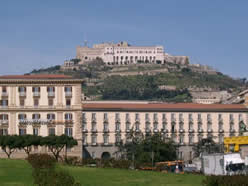
Certosa di San Martino: The Certosa di San Martino is a monastery that seems more like a palace. The Carthunsian monks were forward looking and from the 16th to the 18th centuries the greatest artists of the time worked at the Certosa of San Martino. The original look of San Martino was gradually altered by Mannerist and baroque rebuilding. The most radical redecoration and enlargement was carried out by the architects Giovanni Antonio Dosio, who took over in 1623. The 17th and 18th centuries brought further changes. The French deconsecrated the monastery in 1806, and since 1866 it has housed the San Martino museum with displays of Neapolitan art and history.